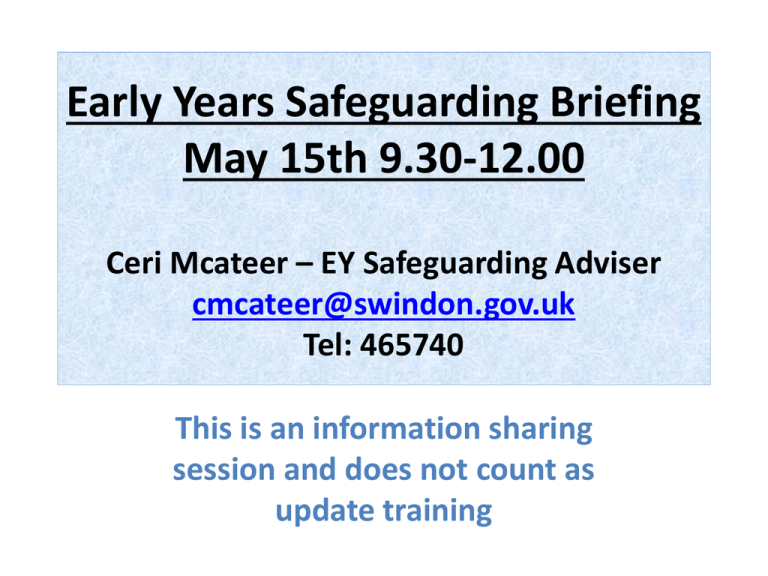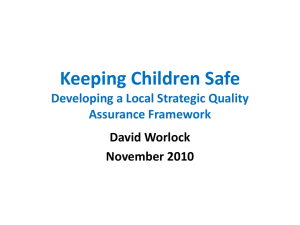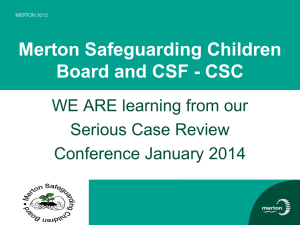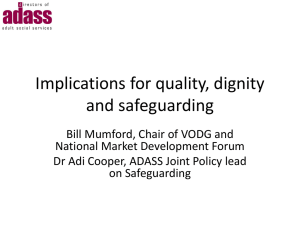Early Years Safeguarding Briefing - May 2013
advertisement

Early Years Safeguarding Briefing May 15th 9.30-12.00 Ceri Mcateer – EY Safeguarding Adviser cmcateer@swindon.gov.uk Tel: 465740 This is an information sharing session and does not count as update training Welcome Housekeeping Agenda Aim of the session: To provide safeguarding updates and information to CP Leads and managers of settings. Kathy Macdonald SBC Integrated Services Manager An introduction to Assessment using Signs of Safety in Early Years What do you want for the children in your care? What have children told us that they want? • The Every Child matters 5 outcomes…5 responses elicited from a 2 year study with the children and the childrens’ workforce Assessment • What is an Assessment? • Why would we do one? When you sense there are problems where do you begin? Beach ball exercise child Congratulations! • You have just started an assessment….organising your thoughts and knowledge about a child is where you start • Where would you go next to get more information? Gathering information based on evidence Working with family to find out what the worries are Meet regularly to see what is working: REVIEW Helping to draw up an Action Plan that involves everyone SBC: Strengthening Families and A 5 year Implementation Plan So what is this SOS about? Strange you should ask.. 1.Empowering families to make their own changes in order to build resilience and coping strategies 2.Getting the extended family, network of friends and neighbours and the community to support and monitor 3.Reducing the reliance and dependency upon services. 4.The child is at the centre of the assessment and the planning. Hanging in there? So what is coming in? and what is going out? IN • Training which focuses on ASSESSMENT • Paperwork designed to support a Single Assessment • Joined up training with the Lscb, covering the transition from Stage 1 assessment through to a child in need and child protection. • Training for JOINT FAMILY PLANNING meetings • Application workshops • Tools to ensure the child/young person is heard and involved OUT • The CAF form as we know it. • TACs in their traditional sense • A culture of services fixing the family • Handing families “over” What is coming your way? • Training about “Signs of Safety” • Training for “Assessment” • Training to use the tools for Assessment • Support for new Family Meetings Ian Durnin Duffy SBC - One Children’s Workforce Manager Safeguarding Training Requirements for EY Settings CP Leads – Advanced level Training (2 days) updated every 2 years. Other training should include; • Safer Recruitment (updated every 5 years), • Allegations • Conferences and Core Groups. Deputy CP Leads – Foundation plus training (1 day) updated every 2 years All other staff - Child Protection Awareness Training - updated every 3 years Committees – the named person for Safeguarding is advised to attend Child Protection Awareness, Allegations and Safer Recruitment training. An Owner, who is different to the manager, is advised to attend Child Protection Awareness, Allegations and Safer Recruitment training. To book training please visit the Early Years Childcare website at www.earlyyearschildcare.org or The Local Safeguarding Children’s Board website at http://www.swindonlscb.org.uk/trainingcalendar2012-13pdf Areas of Responsibility for the Designated Safeguarding Lead in Settings • To have a knowledge of the Government’s statutory guidance eg “Working Together” and “What to do if You’re Worried a Child is being Abused”. • To ensure that there is an up to date child protection policy, which is reviewed annually and is known by all staff and volunteers and available to parents. • To attend your own safeguarding training and to ensure all staff attend training as recommended by the Local Authority. Areas of Responsibility for the Designated Safeguarding Lead in Settings (continued) • To keep abreast of new information relating to safeguarding and to cascade relevant information to staff • To provide support, advice and guidance to staff on any safeguarding issue as required (supervision) • To liaise with other agencies eg know who to contact to make a referral, report an allegation etc. • To know how the Local Safeguarding Children’s Board(LSCB) operates and the South West Child Protection Procedures (SWCPP)eg relating to allegations, safer recruitment etc. Areas of Responsibility for the Designated Safeguarding Lead in Settings (continued) • To ensure all new staff have induction training covering child protection and safeguarding procedures • To organise and manage the keeping of detailed, accurate and secure written child protection records and to ensure they are transferred in line with guidance. • To complete annual safeguarding audit. Areas of Responsibility for the Designated Safeguarding Lead in Settings (continued) • To keep Ofsted notified of any Safeguarding issues as necessary. • To monitor safeguarding policy and procedures in the setting. With your colleagues on your table, take a couple of minutes to discuss, which part of your role of designated CP lead or deputy you find most challenging Local and National Updates Working Together to Safeguard Children (2013) • The new guidance came into force on April 15th 2013 and replaces the 2010 document. • The new guidance streamlines previous guidance documents to clarify the responsibilities of professionals towards safeguarding children and strengthen the focus away from processes onto the needs of the child. • The document can be downloaded from; https://www.education.gov.uk/publications/standard/pu blicationDetail/Page1/DFE-00030-2013 Ofsted Fact Sheet-Records, policies and notification requirements of the EY register (January 2013) A useful document to check that you are; • keeping the regulatory written records for information about children, staff, policies and practices. • Keeping Ofsted informed of relevant new/changes to information and informing them of relevant incidents/events within the required timescale. Changes to DBS Checks (26/3/2013) The Home Office has started the legislative process (subject to agreement by Parliament) so that certain old and minor cautions and convictions will no longer be disclosed on a DBS certificate. The filtering rules which are now before parliament for consideration are: Changes to DBS Checks (Cont.) An adult conviction will be removed from a criminal record certificate if: • 11 years have elapsed since the date of conviction • It is the person's only offence and • It did not result in a custodial sentence. Even then, it will only be removed if it does not appear on the list of specified offences. If a person has more than one offence, then details of all their convictions will always be included. Changes to DBS Checks (Cont.) An adult caution will be removed after 6 years have elapsed since the date of the caution and if it does not appear on the list of specified offences. The changes will not come into force until after the legislation has completed its passage through Parliament. Until then, it's business as usual. Further information available at https://www.gov.uk/government/news/filteringof-oldand-minor-convictions-and-cautions LSCB-Supervision Questionnaire • 95 questionnaires circulated - 37 returned. • Safeguarding supervision sessions are happening regularly, but mainly on an informal basis. • Overwhelming view that safeguarding supervision sessions are useful. • Very few managers have attended any supervision training. Supervision Questionnaire - Recommendations • The LSCB will produce some key safeguarding principles (multi-agency). • Examples of good practice would be beneficial. • All supervision should include safeguarding as necessary • LSCB website to include some supervision information • The provision of some supervision training which will include safeguarding supervision is to be investigated Transition of Child Protection Records • Transfer within 14 days of child leaving • Complete “Transfer of Information Form” • Original copy of records retained, photocopy passed on • All CP records transferred separately from other records - marked confidential • Records passed on face to face, to CP Lead at next setting if possible. Transition of Child Protection Records (continued) • If you are not informed of the next setting but have a CP record, retain records for 5 years • If you are not informed of next setting but there is social care involvement, inform the social worker immediately • Refer to “EY Guidance for keeping CP records” on www.earlyyearschildcare.org for further guidance. Training the Trainer Using NSPCC training materials to deliver inhouse CP training. Monday July 1st -1-4pm A couple of other things……………. Evaluation and EY Questionnaire Thank you for coming. I hope you have found the session useful. Please fill out an evaluation form and questionnaire before you leave.




